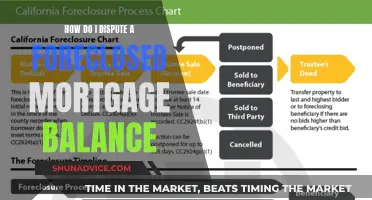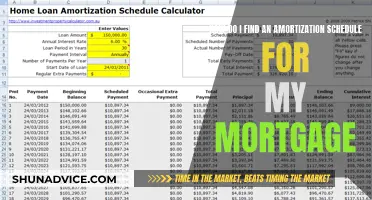
Carrying a mortgage on a property, also known as owner financing, is an alternative investment option for buyers who don't qualify for a traditional mortgage. In this arrangement, the property owner acts as the lender, eliminating the need for a financial institution. The buyer agrees to repay the purchase amount over time, typically signing a promissory note outlining the loan terms and making monthly payments directly to the seller. This provides flexibility and can result in a faster closing on the property. However, there are risks for the seller, including the possibility of buyer default, and complex legal steps involved in foreclosure. Additionally, the seller may need to initiate foreclosure or assume responsibility for the property's state if the buyer defaults. Overall, carrying a mortgage can be a complex but viable option for both buyers and sellers, offering benefits such as passive income and faster property sales.
Characteristics and Values of Carrying the Mortgage on a Property
| Characteristics | Values |
|---|---|
| Type of financing | Owner-financing, seller-financing, private mortgage, purchase-money mortgage |
| Who it is for | Buyers who don't qualify for a traditional mortgage |
| Benefits to the buyer | Faster closing on the property, no need to navigate the traditional mortgage loan process |
| Benefits to the seller | Monthly passive income, higher interest rate than other financial investments, opportunity to diversify income streams |
| Down payment | Minimum of 10%, 20% is safer |
| Risks | Buyer decides not to pay, buyer defaults on payments |
| Other options | Lease-option, lease-purchase, land-contract, contract-for-deed, equity-sharing, wrap mortgages |
What You'll Learn

Pros and cons of carrying the mortgage on a property
Carrying a mortgage, also known as seller financing, is when a property owner acts as the lender to the buyer. This type of financing is often a last resort for buyers who cannot obtain a conventional mortgage. Here are some pros and cons of carrying a mortgage on a property:
Pros
- Monthly income: The seller receives monthly payments from the buyer, providing a regular source of passive income.
- No upfront cost: The buyer avoids the need for a large upfront payment, such as a down payment or closing costs, as the payments are made directly to the seller.
- Leniency: The conditions of the loan can be more lenient and tailored to the specific needs of the buyer, including lower interest rates and down payments.
- Speed: The mortgage process can be faster than with a traditional lender, as there is no need to deal with a bank or other financial institution.
- Credit score: Having a mortgage can benefit the buyer's credit score, provided that they make their payments on time.
- Tax benefits: There may be tax benefits for the buyer, such as the ability to deduct interest on mortgage debt.
Cons
- Risk: The seller takes on the risk of the buyer defaulting on the loan, which could result in legal proceedings and foreclosure.
- Limited investment opportunities: Holding a mortgage can limit the seller's ability to invest in other opportunities or use the money from the sale for different purposes.
- Property maintenance: The seller may be responsible for property maintenance and repairs if the buyer fails to do so.
- Higher interest rates: Holding mortgages may come with higher interest rates than traditional mortgages, increasing the cost for the buyer.
- Lack of regulation: These mortgages may not be regulated by the same consumer protection laws as traditional mortgages, potentially leaving both parties more vulnerable.
Adding Your Spouse to Your Mortgage: What You Need to Know
You may want to see also

How to 'hold paper' (carry a mortgage)
Holding paper, also known as carrying a mortgage, is a type of private financing where the property owner acts as the lender. This means that the buyer repays the seller over time, rather than obtaining a mortgage from a bank.
Advantages of holding paper
Holding paper can be a great way to sell your home quickly and earn some extra income. It can also be a win-win situation for both the buyer and seller, as the buyer may be able to own a home that they otherwise wouldn't have been able to, and the seller can get a competitive price for their home. It can also provide flexibility and simplify the transaction, especially if the buyer and seller know each other. Additionally, it can be a good option for those who need to sell one house to be able to purchase another.
Disadvantages of holding paper
Seller financing is often treated as a last resort, as there is a risk that the buyer will not pay. If the buyer defaults on the loan, the seller may be responsible for making up all back payments on both mortgages, as well as future payments until the holder of the primary mortgage forecloses. There is also a risk that rising interest rates will reduce the resale value of the mortgage note.
How to hold paper
If you are considering holding paper, it is important to take precautions and ensure that the agreement is clear and foolproof. It is recommended to have a real estate attorney or another qualified professional handle the paperwork and review the agreements before they are signed. You should also obtain the buyer's written permission to check their credit, employment, personal references, and previous landlords or lenders. A home appraisal can also help you know the true market value of your property so you can negotiate offers and have an acceptable down payment in mind.
Tax implications
If you sell your home at a profit, you may be subject to capital gains tax. This can be calculated by dividing your total gain by the selling price of the property, then multiplying each year's payments (excluding interest) by the gross profit percentage to find the taxable gain for that year. However, the IRS provides a significant exclusion on the sale of a primary residence. If you have owned and lived in the home as your main residence for at least two years out of the five years before the sale, you may be able to exclude up to $250,000 of the gain from your income, or $500,000 if you're married and filing jointly.
Becoming a Mortgage Processor: A Step-by-Step Guide
You may want to see also

Owner-financing or seller financing
Owner-financing, also known as seller financing, is a type of real estate transaction where a buyer enters into a financing arrangement directly with the seller, instead of borrowing a mortgage loan from a bank or another financial institution. In this arrangement, the property owner acts as the lender, extending credit to the buyer and making the purchase possible. This option is often sought when the buyer does not qualify for traditional financing due to a short or shaky credit history, low credit score, or unconventional income. It is also a good option for buyers who are new to their jobs, self-employed, or retired/semi-retired with lots of savings but little in the way of monthly income.
The owner-financing contract can be structured in several ways, including as a second mortgage, a rent-to-own contract, or a wraparound loan. The owner-financing contract stipulates that the home seller will provide some or all of the financing directly to the buyer. The buyer repays that loan to the seller per the terms of the contract, which are negotiated and agreed upon by both parties. These terms include the purchase price, down payment amount, interest rate, repayment schedule, and term length. The contract should also include a clause requiring the buyer to keep up with property taxes and fire insurance payments.
Owner-financing arrangements typically involve shorter terms than conventional mortgages, usually lasting five to 10 years, and often concluding with a balloon payment. This balloon payment is a large, lump-sum payment that repays the loan in full, and the buyer may need to apply for refinancing when it becomes due. It is important to note that rates are often higher with owner-financing, resulting in higher monthly payments for the buyer.
While owner-financing can provide flexibility and access to homeownership, it is not without risks for both parties. For buyers, there is a risk of losing the home if they cannot make the balloon payment when it becomes due. For sellers, there is a risk of losing money if the buyer defaults on payments and leaves the property in disrepair. Due to these risks, owner-financing is often treated as a last resort. It is recommended that both parties engage legal professionals to draft the right documentation and mitigate legal risks.
Becoming a Mortgage Advisor: Steps to Take
You may want to see also

Tax implications of carrying a mortgage
Carrying a mortgage, also known as "holding paper" or seller financing, is when a property owner acts as the lender, eliminating the need for a financial institution. In this arrangement, the buyer signs a promissory note with the seller, agreeing to repay the purchase amount plus interest according to mutually agreed-upon terms. While this type of financing can provide flexibility and simplify the transaction, it also carries risks and potential tax implications for the seller.
When a seller carries a mortgage, they may encounter tax implications related to capital gains and income tax. If the seller still has a loan on the property and enters into a seller-financed agreement, there could be penalties for prepayment or originating additional debt. The seller may also be responsible for making payments on both the original loan and the new loan if the buyer defaults.
In terms of capital gains tax, the seller may be able to defer a portion of the gain to the future if they finance the sale. This is known as an installment sale, where the buyer makes payments over time. The seller will typically have to pay tax on the gain from the sale, which is calculated by subtracting the cost basis (the amount the seller originally paid for the property) from the selling price. This gain is then taxed at capital gains rates, which are usually lower than ordinary income tax rates.
Additionally, the seller may have to pay regular income tax on the interest received from the buyer each year. This interest income is taxed at ordinary rates and can impact the seller's overall taxable income. It's important for sellers to understand these tax implications before entering into a seller-financed agreement to ensure they are compliant with tax regulations and are prepared for any potential tax liabilities.
Overall, carrying a mortgage on a property involves financial risks and tax considerations. While seller financing can provide benefits such as flexibility and simplified transactions, sellers should carefully evaluate the potential tax implications and seek professional advice to ensure they comply with tax laws and make informed decisions regarding their financial obligations.
Unlocking More Mortgage Money: Strategies for Bigger Borrowing
You may want to see also

The process of carrying a mortgage note
Carrying a mortgage note, also known as "holding paper", is a process that involves the seller of a property acting as the lender to the buyer. This means that the buyer obtains funding from the seller instead of a traditional lender like a bank. Here is a step-by-step guide on the process of carrying a mortgage note:
Step 1: Understanding the Basics
Before proceeding, it is essential to comprehend the fundamental concept of carrying a mortgage note. In this arrangement, the property seller offers financing to the buyer, eliminating the need for a conventional mortgage lender. The buyer signs a promissory note, agreeing to repay the purchase amount, which includes interest, according to mutually agreed-upon terms.
Step 2: Negotiating and Drafting the Agreement
The seller and buyer negotiate and agree upon all aspects of the financing arrangement, including the purchase price, down payment amount, interest rate, repayment schedule, and term length. It is crucial to involve legal professionals to draft the necessary documentation, including promissory notes and contracts. These documents should clearly outline payment terms, interest rates, and consequences in the event of default by either party.
Step 3: Understanding the Risks
Carrying a mortgage note involves certain risks. If the buyer defaults on the first lien, the seller may be responsible for making up all back payments on both mortgages, as well as future payments, unless they choose to foreclose. Therefore, it is advisable to demand a large down payment from the buyer to mitigate this risk. Additionally, it is recommended to obtain written permission to check the buyer's credit history, employment, personal references, and previous landlords or lenders.
Step 4: Finalising the Agreement
Once the terms are finalised and the documentation is prepared, the buyer and seller sign the promissory note and mortgage or deed of trust. The promissory note outlines the loan terms, while the mortgage or deed of trust secures the property as collateral. The mortgage note becomes a legally binding agreement between the seller and buyer, with the seller having the right to initiate foreclosure proceedings if the buyer defaults on their payments.
Step 5: Post-Agreement Considerations
After the agreement is finalised, the seller should periodically check with the holders of other loans on the property to ensure timely payments. Additionally, the seller has the option to sell the mortgage note on the secondary market, freeing themselves from the risks of carrying the loan and receiving a lump sum payment for other investments.
Carrying a mortgage note can provide flexibility and access to a wider pool of buyers, but it is important to carefully consider the risks and legal implications involved.
Steps to Applying for a Mortgage: A Guide
You may want to see also
Frequently asked questions
A holding mortgage is a type of non-conforming loan that involves owner financing. The homeowner acts as a lender to the home buyer, offering them a loan to finance their purchase.
Holding mortgages can be a good option for buyers who don't qualify for a traditional mortgage. They also offer more flexibility than traditional mortgage options, and the process is usually faster.
Holding mortgages usually have a higher interest rate than traditional mortgages. There is also the possibility of a large balloon payment at the end of the repayment term.
If the buyer defaults on their payments, the seller may have to initiate foreclosure or assume responsibility for the state of the property. There are also complicated legal steps involved in foreclosure that could be costly.
Try to structure the deal so that monthly payments are enough to pay off the entire loan in the shortest amount of time. Demand a large chunk of change upfront — at least 10% and preferably 20%.







